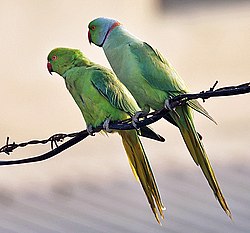| Psittaculidae | |
|---|---|
 | |
| Rose-ringed parakeets (Psittacula krameri) | |
| Scientific classification | |
| Kingdom: | Animalia |
| Phylum: | Chordata |
| Class: | Aves |
| Order: | Psittaciformes |
| Superfamily: | Psittacoidea |
| Family: | Psittaculidae Vigors, 1825 |
| Subfamilies | |
Psittaculidae is a family of parrots, commonly known as Old World parrots, though this term is a misnomer, as not all its members occur in the Old World, and the Psittacinae also occurs in the Old World. It consists of six subfamilies: Psittrichasinae, Agapornithinae, Loriinae, Platycercinae, Psittacellinae and Psittaculinae.